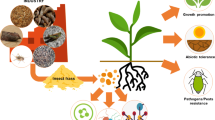Abstract
The noncontingent distribution ofO. nubilalis Hbn. eggs on various corn varieties has allowed their classification as either “favorable” or “nonfavorable” hybrids. This classification is based on a chemical communication system using volatile compounds active at a distance from the insect or active when in contact with the insect as soluble sugar components. Under this hypothesis, gas chromatography is the best way of investigating for the chemical differences between corn silk extracts from the two types of hybrids. A first experiment, using a “desorption-trapping” system on Tenax coupled to a gas chromatograph showed a quantitative difference between two compounds from the two hybrids. A second experiment showed the advantages and disadvantages of this method and allowed the development of two complementary techniques: (1) direct extraction of corn silk with trichlorofluo-romethane and direct injection into a capillary column with an apolar stationary phase using an “on-column” system; and (2) extraction under vacuum of volatile compounds from corn silk and their trapping on Tenax, followed by a second desorption. This allows a direct injection on the same capillary column. The first technique allows identification by mass spectrometry of many alkanes with high molecular weights. The second technique seems to confirm the presence of phenylacetaldehyde. Both techniques show quantitative differences in the composition of corn silk extracts from “favorable” and “nonfavorable” hybrids; however, the biologically active chemicals remain unknown.
Similar content being viewed by others
References
Anglade, P., Derridj, S., andDurand, Y. 1981. First observations upon the preference for oviposition of the European corn borer and their significance in breeding for resistance.O.I.L.B. Bull. 4(1):105–108.
Buttery, R.G., andLing, L.C. 1984. Cornleaf volatiles: Identification using Tenax trapping for possible insect attractant.J. Agric. Food Chem. 32:1104–1106.
Cantelo, W.W., andJacobson, M. 1979. Corn silk volatiles attract many pest species of moth.J. Environ. Sci. Health A 14(8):695–707.
Derridj, S., andFiala, V. 1983. Sucres solubles des feuilles de maīsZea mays L. et oviposition de la pyraleOstrinia nubilalis Hbn.C.R. Acad. Agric. Fr., 69:465–472.
Finch, S., andSkinner, G. 1982. Trapping cabbage root flies in trap baited with plant extracts and with natural and synthetic isothiocyanates.Entomol. Exp. Appl. 31:133–139.
Flath, R.A., Forrey, R.R., John, J.O., andChan, B.G. 1978. Volatile components of corn silk (Zea Mays L.): possibleHeliothis zea Bod. attractants.J. Agric. Food Chem. 26:1290–1293.
Maeshima, K., Hayashi, N., Murakami, T., Takahashi, F., andKomae H. 1985. Identification of chemical oviposition stimulants from rice grain forSitophilus zea-maīs Motschulsky (Coleoptera, curculionidae).J. Chem. Ecol. 11:1–9.
Lecomte, C., andThibout, E. 1981. Attractiond'Acrolepiopsis assectella, en olfactométrie par des substances allélo-chimiques volatiles d'Allium porum.Entomol. Exp. Appl. 30:293–300.
Muckensturm, B.,Duplay, D.,Mohammad, F.,Moradi, A.,Robert, P.C.,Simonis, M.T., andKienlen, J.C. 1982. Le rôle des phénylpropanoĩdes naturels en tant qu'anti-appétants pour insectes, pp. 131–136,in INRA (ed.). Les médiateurs chimiques, Vol. 7. Les Coll. de l'INRA. 414 pp.
Städler, E. 1978. Chemoreception of host plant chemicals by ovipositing females ofDelia (Hylemya) brassicae.Entomol. Exp. Appl. 24:711–720.
Visser, J.H., Van Straten, S., andMaarse, H. 1979. Isolation and identification of volatiles in the foliage of potatoSolanum tuberosum, a host plant of the Colorado beetleLeptinotarsa decemlineata.J. Chem. Ecol. 5:13–25.
Woodhead, S., 1983. Surface chemistry ofSorghum bicolor and its importance in feeding byLocusta migratoria.Physiol. Entomol. 8:345–352.
Author information
Authors and Affiliations
Rights and permissions
About this article
Cite this article
Stockel, J., Bar, M., Boidron, J.N. et al. Methodological approach to identify chemical oviposition stimulants from maize for European corn borer. J Chem Ecol 13, 557–567 (1987). https://doi.org/10.1007/BF01880099
Received:
Accepted:
Issue Date:
DOI: https://doi.org/10.1007/BF01880099




